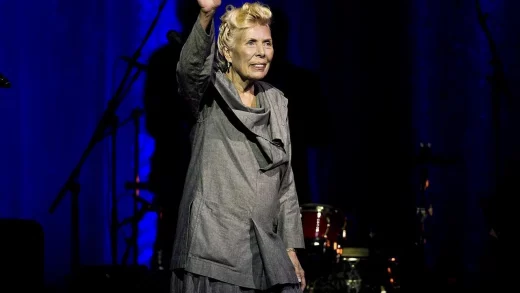:format(webp)/https://www.thestar.com/content/dam/thestar/entertainment/books/2023/03/31/in-cherie-dimalines-latest-book-funeral-songs-for-dying-girls-a-young-woman-grapples-with-grief-and-ghosts/cherie_dimaline_credit_wenzdae_brewster_4.jpg)
Books can be magical things. Especially when they get young people engaged in reading and the world around them. Perhaps even more so when they spark their — and our — imaginations, or change the way we see the world.
Reading doesn’t come easily to every young person. Although I’m close to one who has read author Cherie Dimaline’s “The Marrow Thieves” multiple times. In her class is an Indigenous boy who is excited that there’s a book he relates to on the curriculum. They’re in a group together, these two, and they talk about the book and the issues and examine their own relationship to the text and the ideas it sparks.
“That’s got to be a kick,” I suggested, as Dimaline and I chatted over Zoom from her home north of Toronto.
“It was the best thing that I could never have hoped for; I didn’t even dare to dream that big,” she said. “The most beautiful experience is talking to these kids and seeing the ways that they connect to the story.”
But not everyone is happy about the tale. A few weeks ago in Bozeman, Montana, parents went to the media, asking that “The Marrow Thieves” be removed from the Grade 9 school curriculum. The book features a dystopian near-future in which non-Indigenous people have lost their ability to dream, which has led to widespread madness. They can only fix it by eating the bone marrow of Indigenous Peoples, who are unwillingly harvested for the cure in marrow-harvesting factories (not unlike residential schools).
One parent told local television station KBZK that “Keeping this book in the curriculum fosters religious bias toward the church and Catholic students … You’re willing for students’ minds to be poisoned by the sophistry of Canadian history.” Other parents were more sanguine: “I think this book encourages critical thinking by students,” the station reported one parent saying, and another that “If we begin to ban books because a narrative doesn’t align with one family’s beliefs, where do we draw that line on banning books?”
Dimaline has a slightly different take. “My experience talking to students from all different backgrounds has never been them feeling attacked or left out of the story. It’s about (them saying) ‘How do I do better? How do I come together? I wouldn’t let this happen again.’ It turned me into a bit more of an optimist, which is a hard thing to do with me because, man, the kids are all right.”
She might not be an optimist, but she was animated and laughed easily as we talked. It’s a bit of a contrast to what seem like the distinctly dark themes she’s chosen for her latest book for young adults, “Funeral Songs for Dying Girls.”
Win — short for Winifred — is “struggling to live” in surroundings that at first glance seem pretty grim. Her father is the caretaker of a cemetery — set around the downtown Regent Park area of Toronto; the Necropolis has obviously provided inspiration — and they live in an apartment above the administrative offices. Her mother died when Win was young; she is interred in the cemetery and her father wears his grief heavily. He is white, her mother was Métis and the one character who connects Win to that community, her Aunt Roberta, dies.
Win is really living in a liminal world: between life and death, childhood and adulthood, and trying to understand who she is and her mixed heritage. It’s a coming-of-age story, but also a creation story.
“I think that the work of our younger years is not really about finding yourself, it’s about creating yourself,” Dimaline explained. “This is the story of one girl in very unusual circumstances doing that work of creating herself. She’s trying to understand so much about herself and the world.”
No wonder the narrative is packed with ghosts, the ultimate liminal character: neither here nor there but occupying some magical space in between.
Both this book and “VenCo,” Dimaline’s latest for adults that came out earlier in the spring — the Star’s reviewer called it “a thriller to take down the patriarchy and save the world” — have very obvious supernatural elements: the former features seven witches, and the latter ghosts and a graveyard. Both of the books were written during the pandemic and Dimaline mused on how they are really about connection. While we were locked down, we were feeling homesick for each other, for community, and perhaps lost an idea of our own spirituality along the way.
“We felt so disconnected … especially for people who had belief systems that involve being in a certain building or having this sort of man who’s the intermediary between you and your God.”
She wanted, she said, to “shake people out of the amnesia (and remind them) that we’re already connected; we’re already powerful. That’s not a dig on anyone’s belief system.”
As Win is trying to figure things out, heading toward her 16th birthday and kind of friendless except for best friend Jack, on whom she’s developed a decided crush, she meets a ghost in the graveyard: Phil. Phil is young — well, she was young when she died — and provides something of a buffer, it seems to me, between the dead and the living.
Plus the book is full of bones: in the cemetery, naturally, but also there’s the idea of things that are bred in the bone and Win collects bones. Again, there’s a sense of hovering somewhere between the physical and supernatural worlds.
One of the ideas Dimaline wanted to explore was the difference between ghosts and spirits, between the deceased and ancestors.
“One is very lonely, right?” she said. “A ghost is sort of a wandering, empty, yearning thing and a spirit is a full potential of something beautiful.” But the other is the idea of where we come from, where we fit in.
Going back to our experience of the pandemic, she said that, at a time when we were forced to live apart from each other, many of us were “in close quarters with things like grief and anxiety. I wanted to look at that grief: where does it live in our body? What are the ways in which it informs our life? How do we use it … so that it emboldens us and it’s not a weight that holds us down?”
Like so many writers trying to get to the core of things, she taps into one of the most primeval experiences we have, delving into fairy tales and the idea of the motherless child. Do we need to be motherless — at least in fairy tales and coming-of-age stories — in order to grow?
“Without a mother it feels like in most circumstances that then you have a child who is truly alone, profoundly alone. And we know that even as adults when we lose a parent there’s something about standing alone. When (the Indigenous writer and artist) Lee Maracle passed, who was incredibly important in my life, the world immediately felt different. I felt smaller. I felt more fragile.”
Knowing that Maracle was in the world, Dimaline said, made her feel protected somehow. “She helped me to see my place in the world.”
Dimaline also references Canadian writer Heather O’Neill’s “incredible, incredible” characters, the kind of characters “my characters would want to be when they grow up,” the kind seen most recently in O’Neill’s novel “When We Lost Our Heads.”
“They’re characters that refuse shame, they refuse the weight of shame. They have wants and needs, and they say it and they act on it,” said Dimaline. “And her characters very often are these motherless individuals kind of wandering the landscape and really owning it. I’m always inspired by her work in that way. I have these characters that have the strength to bear their humiliation, and try and rise, but they still do feel that sting.”
The other book Dimaline is out with this spring is “An Anthology of Monsters: How Story Saves Us From Our Anxiety.”
Dimaline had, she told me, her first panic attack when she was seven years old. It went undiagnosed for a long time. “And so I lived with fear which, of course, is really not the best thing to put with anxiety. I spent a lot of years making myself as small as possible.”
That made her “really vulnerable to problematic people. I had made myself so tiny, which takes away your voice.”
When she was about 20, and a single mom, she went to the doctor, an older man sitting behind a desk. He asked her what she was there for and “I just started crying. I (said) ‘I think I’m losing my mind. I can’t think, I can’t breathe sometimes.’”
He looked at her, she recounted, told her she had anxiety and gave her a prescription. In that moment, he named it, named what she was experiencing and that was empowering — because once something is named it can be externalized.
That is also part of the power of storytelling: Dimaline is reminded, she said, of Neil Gaiman saying about stories (the quote is about fairy tales in particular) that the point isn’t to tell you that dragons exist, but that they can be defeated.
Which, really, is what Dimaline is getting at in all of her books. The idea of empowering: women, people with anxiety or young people trying to figure out their place in the world.
Telling stories, including her own, was her way of contributing to that, of letting people know they’re not alone.
Maybe that’s why, after “The Marrow Thieves,” which had a pretty open-ended ending even though she figured it would be a stand-alone novel, she decided to write a sequel. “I was peer pressured into it by thousands and thousands of lovely kids” who could reach out to her thanks to social media and who wanted to have a conversation. How could she say no?
The ending to “Funeral Songs for Dying Girls” is pretty open-ended too — no spoilers, we find out pretty close to the beginning that Win and her dad are leaving the city and heading out to B.C. — but we don’t know what’s going to happen.
“If people fall in love with Winifred and Phil, and really need that to be a part of their life, that’s a conversation I’m willing to have,” Dimaline said.
“Lee (Maracle) used to always say you have to stand for your stories. You can’t just write them and let them go. My responsibility is to stand back, but also maybe to sit down and keep writing.”
JOIN THE CONVERSATION
does not endorse these opinions.
:format(webp)/https://www.thestar.com/content/dam/thestar/entertainment/books/2023/03/31/in-cherie-dimalines-latest-book-funeral-songs-for-dying-girls-a-young-woman-grapples-with-grief-and-ghosts/funeral_songs_for_dying_girls.jpg)



